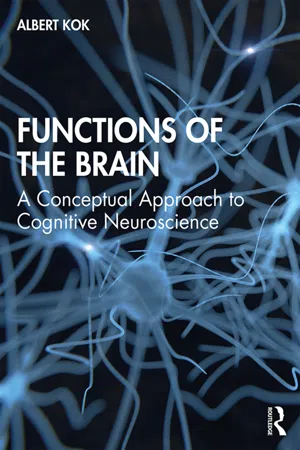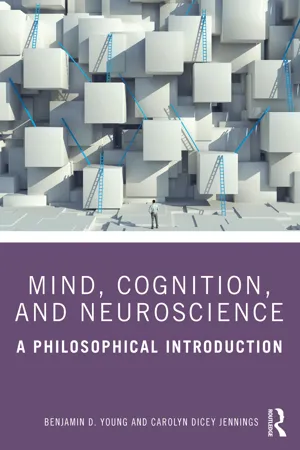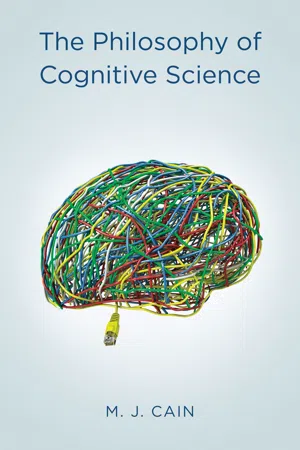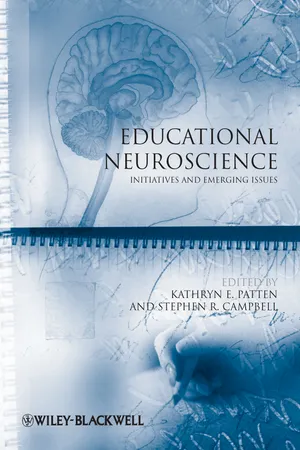Cognitive Neuroscience
Cognitive neuroscience is the study of how the brain enables the mind to function. It combines principles from psychology and neuroscience to understand mental processes such as perception, attention, memory, language, and decision-making. By using various techniques such as brain imaging and electrophysiology, cognitive neuroscientists seek to uncover the neural mechanisms underlying cognitive functions.
8 Key excerpts on "Cognitive Neuroscience"
- eBook - ePub
- Craig E. Carroll(Author)
- 2016(Publication Date)
- SAGE Publications, Inc(Publisher)
...Cognitive Neuroscience explores the connections between the functions of the brain and human behavior. Social Cognitive Neuroscience, which examines social phenomena with theories from social science and Cognitive Neuroscience methodological tools, is a particularly significant contemporary branch. Because of its multidisciplinary nature, scholars applying neuroscience come from different backgrounds, including the social sciences, psychology, social psychology, and medicine. In the context of corporate reputation studies, neuroscience remains unexplored territory, though some studies have enlisted methodological toolboxes from the area of Cognitive Neuroscience. New Branches of Neuroscience Traditional neuroscience has its roots in biology but has begun to reach different fields of study, including psychology, social psychology, economics, marketing, and brand studies. These new branches are sometimes referred to as neuroeconomics, neuromarketing, and neuropsychology, to name a few. Neuroeconomics combines neuroscience, economics, and psychology. Researchers in this field are interested in explaining human behavior in the context of financial markets, consumption, loss aversion, and other types of economic behaviors. Neuroeconomics seeks a deeper understanding of how humans make decisions by examining what happens in the human brain when individuals make choices among options and calculate risks, costs, and profits. In neuromarketing, the interest is focused on consumers’ cognitive and affective responses to marketing-related stimuli. For example, researchers have highlighted the role of emotions in brand evaluations using brain-imaging studies. Not surprisingly, neuromarketing innovations in science have spread to the business sector, where firms are looking for more effective ways to market products and services...
- eBook - ePub
- Jamie Ward(Author)
- 2019(Publication Date)
- Routledge(Publisher)
...It has emerged as a distinct enterprise only recently and has been driven by methodological advances that enable the study of the human brain safely in the laboratory (see Figure 1.1). It is perhaps not too surprising that earlier methods, such as direct electrical stimulation of the brain, failed to enter into the mainstream of research. Figure 1.1: A timeline for the development of methods and findings relevant to Cognitive Neuroscience, from phrenology to present day. ONLINE RESOURCES To discover more about Wilder Penfield and his pioneering research, watch the videos found on the companion website (www.routledge.com/cw/ward). KEY TERMS Cognition A variety of higher mental processes such as thinking, perceiving, imagining, speaking, acting and planning. Cognitive Neuroscience Aims to explain cognitive processes in terms of brain-based mechanisms. Mind–body problem The problem of how a physical substance (the brain) can give rise to our sensations, thoughts and emotions (our mind). KEY TERMS Dualism The belief that mind and brain are made up of different kinds of substance. Dual-aspect theory The belief that mind and brain are two levels of description of the same thing. Reductionism The belief that mind-based concepts will eventually be replaced by neuroscientific concepts. This chapter begins by placing a number of philosophical and scientific approaches to the mind and brain in a historical perspective. The coverage is selective rather than exhaustive, and students with a particular interest in these issues might want to read more deeply elsewhere (Wickens, 2015). The chapter then provides a basic overview of the current methods used in Cognitive Neuroscience. A more detailed analysis and comparison of the different methods is provided in Chapters 3 to 5...
- eBook - ePub
Functions of the Brain
A Conceptual Approach to Cognitive Neuroscience
- Albert Kok(Author)
- 2019(Publication Date)
- Routledge(Publisher)
...1 The birth of Cognitive Neuroscience Contents Introduction The development of Cognitive Neuroscience The mind-brain Methods in cognitive brain research Introduction Cognitive psychology is committed to the study of cognition, a domain traditionally considered as the ‘home base’ of functions like perception, attention, memory, language and consciousness. Human cognition, the ‘knowing part’ of our mind is nonetheless functionally related to another domain of the human mind, emotion, even though they correspond with different divisions of the brain. Emotions and its ‘feeling part’ color cognitive processes and events that we experience or recall. In turn, cognitive processes can influence and control emotional processes. When faced with uncertainty, human organisms will not only engage areas in the brain that developed relatively late in the course of evolution, like the neocortex. Even complex decisions may then appeal to evolutionarily old structures in the limbic system that regulate affective processes. The fusion between rational and irrational processes that often underlies human social decision making (Tversky & Kahneman, 1981; Damasio, 1994) indicates that human emotions and their underlying mechanisms are essential elements to be considered in the study of human cognition. The central issue addressed in the present chapter is how we can conceptualize the relationship between mind and brain and their constituting parts. This will necessarily lead us back to some questions that were initially raised in cognitive psychology as well as in neuroscience, but later were reunited in Cognitive Neuroscience. Our daily behavior depends to a large extent on the amalgam of cognitive and emotional functions, glued together in the seamless unity of our conscious or unconscious mind...
- eBook - ePub
Mind, Cognition, and Neuroscience
A Philosophical Introduction
- Benjamin D. Young, Carolyn Dicey Jennings(Authors)
- 2022(Publication Date)
- Routledge(Publisher)
...As an interdisciplinary field, it utilizes research from biology, medicine, chemistry, computational science, math, physics, and psychology. Naturalism : a philosophical approach that seeks to explain all aspects of reality, especially phenomena studied by the sciences, purely in terms of naturally occurring objects, properties, and relations. Cognitive psychology : a subfield of psychology devoted to studying thoughts, thinking, and the psychological processes responsible for our mental states. Cognitive Neuroscience : a subfield of neuroscience that employs the methods and knowledge base of neuroscience to study cognition and mental phenomena. Philosophy of Cognitive Neuroscience : a combination of philosophy of science and empirically informed philosophy, covering issues regarding both the practice of Cognitive Neuroscience and the evidence yielded by Cognitive Neuroscience. 1. MOTIVATION AND BACKGROUND 1.1. Purpose of Textbook Mind, Cognition, and Neuroscience is designed for interdisciplinary audiences from a range of backgrounds 1. The textbook offers a philosophical introduction to a wide range of contemporary topics that are relevant to the study of mind. Each chapter situates current philosophical research and neuroscientific findings within historically relevant debates. This allows the reader to appreciate the progression of ideas within these multidisciplinary areas of inquiry, while also becoming aware of cutting-edge research. The past few decades have seen a substantial expansion in the sciences of mind, mirrored by the growth of empirically-informed philosophy. This textbook aims to foster further growth and interest in the theoretical issues surrounding topics in the cognitive and neural sciences...
- eBook - ePub
- Mark J. Cain(Author)
- 2015(Publication Date)
- Polity(Publisher)
...6 The Brain and Cognition 1 Introduction What is the relationship between the brain and the mind or between neural states and processes and cognitive states and processes? And what are the implications of the nature of that relationship for the role of the study of the brain in cognitive science? The purpose of this chapter is to address these questions in the light of recent developments in neuroscience and the rising prominence of that discipline both in the scientific community and in the popular imagination. 2 Neuroscience and the history of cognitive science As we saw in chapter 1, cognitive science was founded on the basis of the rejection of substance dualism and of behaviourism. Accordingly, the mind was viewed as a physical system internal to the body that mediated the connections between the world external to the body and bodily behaviour or action. Thus, for example, when a wild animal approaches a person and they respond by throwing a stone in the animal’s direction, that response is mediated by processes internal to the body that serve to identify the wild animal and work out the best way to respond to it given the person’s current goals. As a result of this processing, instructions are issued to the motor control systems so that the person behaves in line with their plans. It was also a foundational assumption of cognitive science that such internal processes take place in the brain, that the brain is the seat of cognition. Given this, one might have expected that neuroscience, the scientific study of the brain, would have played a prominent role in cognitive science throughout its history. However, this has not been the case for several reasons. The first reason why neuroscience has had only a limited role in the history of cognitive science is a practical one...
- eBook - ePub
Educational Neuroscience
Initiatives and Emerging Issues
- Kathryn E. Patten, Stephen R. Campbell, Kathryn E. Patten, Stephen R. Campbell(Authors)
- 2011(Publication Date)
- Wiley(Publisher)
...An important aspect of these activities is to build capacity in neuroscience related to complex human learning and education, and to identify trajectories by which multidisciplinary research anchored in the biological basis of human learning can inform STEM educational practice. The involvement of researchers familiar with STEM educational practice will be of benefit both in helping to set the cognitive and neuroscientific research agendas in learning as well as in helping to disseminate relevant literatures across disciplines. (REESE Program Description. Available online at: http://nsf.gov/pubs/2008/nsf08585/nsf08585.htm) Taken together, I contend that we are beginning to see, across these factors, the basis for a revolution in theorizing about learning that designs and refines its measures, guides its hypotheses, informs its analyses and grounds its conclusions using data from Cognitive Neuroscience studies. I expect that current, apparently incommensurate, theories or general descriptions about learning will be decided more and more on the basis of this growing empirical record. Theories are never abandoned easily, of course, but the disambiguation of claims at the hypothesis testing level using Cognitive Neuroscience data is likely to place upward pressure on theories, which are too often contingent descriptions of learning with little specification of mechanism or grounding in the larger set of findings in science. References Berger, A., Tzur, G. & Posner, M. I. (2006) Infant Brains Detect Arithmetic Errors, Proceedings of the National Academy of Sciences, 103:33, pp. 12649–12653. Binder, J. R., Westbury, C. F., McKiernan, K. A., Possing E. T. & Medler, D. A. (2005) Distinct Brain Systems for Processing Concrete and Abstract Concepts, Journal of Cognitive Neuroscience, 17, pp. 905–917. Bruer, J. T. (1997) Education and the Brain: A bridge too far, Educational Researcher, 26, pp. 4–16. Butterworth, B. (2005) Developmental Dyscalculia, in: J...
- eBook - ePub
Psychology and Adult Learning
The Role of Theory in Informing Practice
- Mark Tennant(Author)
- 2019(Publication Date)
- Routledge(Publisher)
...But while there is much energy and optimism about the application of neuroscience to education, there are also warnings about the significant challenges of such an enterprise. Before considering these challenges, it is useful to outline the approach of neuroscience and its application to education. The project of educational neuroscience De Vos (2016) provides perhaps the best statement of the project of neuroeducation: To begin with, the neuroeducational approach demonstrates how neurological research attempts to bridge two problematic fields: on one plane, the mind and its psychology; and on the other, the brain and its physiology. … The crucial thing to note, here, is that the principal rationale of such research is to establish a parallel between the mind and the brain, between psychological variables and brain regions. (De Vos, 2016: 133) The typical neuroscientific investigation in this area is to map regions of the brain being activated and the temporal changes evident when undertaking a task. Ganasana et al. (2017) and Williams and Henson (2018) provide an overview of neuroscientific techniques, but for the most part the link between behaviour and cognitive process and brain functioning has been made through non-invasive techniques such neuroimaging using functional magnetic resonance imaging (fMRI) and measures of electrical activity such as electroencephalography analysis (EEG) and electro-/magneto-encephalography (E/MEG). It is worth noting that fMRI is an indirect measure of brain activity in that it measures the ratio of oxygenated and deoxygenated blood (blood flow is greatest in regions of the brain that are active). EEG is a more direct measure of the electrical activity of neurons as they ‘fire’ – it is useful for providing temporal detail but it cannot accurately identify the regions of the brain being activated (although MEG has the potential to provide better spatial resolution)...
- eBook - ePub
- Alan Parkin(Author)
- 2016(Publication Date)
- Psychology Press(Publisher)
...Behaviourism takes the view that behaviour cannot be explained by making any appeal to internal structures or processes within the brain. Instead behaviourists sought to account for all human behaviour in terms of the relations between inputs (stimuli) and outputs (responses). In 1959 the linguist Chomsky wrote a powerful critique of the behaviourist approach and, in essence, came to the conclusion that the nature of mental life could not be investigated effectively without some theory about how the structures and processes of the brain were organized and the principles by which they operated (Chomsky, 1959). Experimental psychologists face a challenge encountered in no other science except perhaps sub-atomic physics. There is little disagreement that mental processes take place in the brain and, from microscopic examination, we can see that the brain comprises nerve cells and fibres which interact with one another within a complex network. However, knowing that the mental processes that we seek to understand are a product of the interaction between nerve cells does not help us comprehend how mental processes take place. In short the explanation of psychological processes cannot, at present, be reduced to an understanding of how the brain works at a physiological level. Because of this psychologists are forced to use analogy or metaphor in explanation; that is they attempt to explain the workings of the mind in terms of something else that we do understand. Cognitive psychology can be defined as the branch of psychology which attempts to provide a scientific explanation of how the brain carries out complex mental functions such as vision, memory, language and thinking. Cognitive psychology arose at a time when computers were beginning to make a major impact on science and it was perhaps natural that cognitive psychologists should draw an analogy between computers and the human brain...







